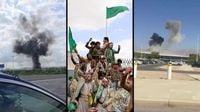On Sunday, September 7, 2025, the simmering conflict between Israel and Yemen’s Houthi rebels took a dramatic turn. A drone fired by the Houthis slipped through Israel’s sophisticated multilayered air defenses and slammed into Ramon International Airport near the southern resort city of Eilat, blowing out glass windows, sending black smoke billowing skyward, and wounding at least two people—a 63-year-old man and a 52-year-old woman—with minor shrapnel injuries. The attack briefly shut down commercial airspace, causing major delays and forcing the diversion of flights. Within hours, however, Ramon Airport resumed full operations after safety and security checks were completed and the Israeli Air Force gave the all-clear, according to the Israeli Airports Authority.
The Houthis, an Iran-backed militant group based in Yemen, quickly claimed responsibility. Brig. Gen. Yahya Saree, a spokesperson for the group, declared that eight drones had been launched at Israel, targeting airports specifically. He warned in a televised statement, “As long as the war in Gaza continues, Israel’s airports are unsafe and will be continuously targeted.” The Israeli military confirmed that it had intercepted three other drones near the border with Egypt and was investigating why the drone that struck Ramon Airport was not detected as a threat. The attack did not trigger air raid sirens at the airport, raising questions about possible gaps in Israel’s vaunted air defense systems.
This incident marks a significant escalation in the nearly two-year-old conflict between Israel and the Houthis, coming just days after Israeli strikes on Yemen’s rebel-held capital killed Houthi Prime Minister Ahmed al-Rahawi and other top officials. The Houthis, for their part, have vowed to intensify their attacks on Israel and on merchant ships navigating the vital Red Sea trade route. The group began its campaign of missile and drone attacks against Israel in November 2023, in what it described as solidarity with Palestinians following Hamas’ deadly October 7, 2023, assault on southern Israel, which killed 1,200 people—mostly civilians—and saw more than 250 abducted, as reported by the Associated Press.
Since resuming all-out war in Gaza in March 2025, the Houthis have stepped up their aerial attacks, firing at least 31 drones and 80 ballistic missiles at Israel, according to Israeli military figures cited by the New York Post. While most of these attacks have been intercepted or caused little damage, the rare strike on Ramon Airport—and a previous missile strike near Ben Gurion International Airport three months prior, which prompted international airlines to cancel flights to Tel Aviv for months—demonstrates the Houthis’ growing reach and capabilities. In a chilling warning, Saree stated that these attacks would not stop as long as Israel’s campaign in Gaza continued.
Meanwhile, the war in Gaza itself saw another grim milestone on Sunday. The Israeli military leveled another high-rise tower in Gaza City, the third in as many days. The building, known as Al-Ra’iya Tower, had housed hundreds of displaced Palestinians. The military claimed the tower was being used by Hamas for intelligence-gathering, an accusation Hamas flatly denied, calling it “a false pretext meant to justify bombing residential blocks.” The destruction sent people scrambling for cover and added to the already staggering displacement in the enclave. According to Los Angeles Times, Israeli military spokesperson Avichay Adraee had ordered the evacuation of residents from the building and nearby tents before the strike, urging civilians to move south to a designated humanitarian zone. Yet, many Palestinians—exhausted from repeated displacement and skeptical of their safety even in so-called safe zones—opted to stay put. As Shireen Al-Lada’, a Gaza resident, put it, “Every time we move to a place, we get displaced from it.”
The humanitarian situation in Gaza continues to deteriorate. Over 64,000 people have been killed in the Gaza Strip since the war began, according to the Gaza Health Ministry, which notes that more than half of the casualties are women and children. On Sunday, Gaza City’s Shifa Hospital reported that Israeli strikes on a school-turned-shelter and on tents and apartment buildings killed at least 13 Palestinians, including six children and three women. In central Gaza, Al-Awda Hospital received five dead bodies, including that of a young girl, after an Israeli strike on the U.N.-administered Nuseirat refugee camp. The Israeli military said it was targeting militants near the school and had warned civilians to evacuate, but said it was investigating reports of civilian casualties.
In a rare move, the Israeli Supreme Court intervened on Sunday, ruling that Israel was not providing Palestinian detainees in its custody with enough food to ensure basic sustenance. The court ordered the state to “guarantee basic living conditions in accordance with the law” for the thousands of Palestinians held in Israeli detention facilities. The ruling came in response to a petition by Israeli human rights groups alleging starvation among Palestinian prisoners and marked a rare instance of judicial restraint on Israel’s war policies, which have drawn widespread international criticism.
On the diplomatic front, U.S. President Donald Trump made waves by claiming on social media that Israel had accepted his terms for a ceasefire in Gaza and urging Hamas to do the same. “I have warned Hamas about the consequences of not accepting. This is my last warning, there will not be another one!” Trump wrote. However, neither Israel nor Hamas confirmed the specifics of his claim. The Israeli prime minister’s office did not respond to requests for comment. Hamas acknowledged receiving “some ideas from the U.S.” via intermediaries and said it “welcomed any initiative” to end the war that included the release of Israeli hostages in exchange for Palestinian prisoners, but maintained its demand for a full Israeli withdrawal from Gaza and formation of an independent Palestinian committee to govern the territory—conditions Israel has consistently rejected. Hamas gave no indication it would disband its armed wing, while Israeli Prime Minister Benjamin Netanyahu has insisted that Hamas’ full disarmament is a non-negotiable condition for any comprehensive ceasefire.
Netanyahu, facing criticism both at home and abroad, remained defiant. At a Cabinet meeting on Sunday, he vowed to press ahead with the ground assault on Gaza City, stating he preferred “a victory over our enemies” to one “over anti-Israel propaganda.” This stance has outraged families of Israeli hostages and their supporters, who fear that a major ground offensive could further endanger the 20 out of 48 hostages still believed to be alive in Gaza. The Hostages and Missing Families Forum, a group representing many hostage families, called on the Israeli government to “declare its unequivocal support for the emerging agreement” and to back President Trump’s initiative until every hostage is returned home.
As the violence continues and diplomatic efforts stall, the region stands at a precarious crossroads. The Houthi drone strike on Ramon Airport has exposed vulnerabilities in Israel’s defenses and signaled the potential for further escalation, while the ongoing humanitarian crisis in Gaza deepens. With both sides holding firm to their conditions and civilians bearing the brunt, the path to peace remains fraught and uncertain.


